Volkswagen Group Bundle
How Does the Automotive Giant, Volkswagen Group, Operate?
Volkswagen Group, a global automotive powerhouse, is a critical player in the industry, consistently ranking among the world's largest automakers. In 2024, it secured its position as the second-largest automaker by sales, making it a dominant force in the European Union. With operations spanning 153 countries and a vast network of production facilities, understanding the inner workings of this multinational conglomerate is essential.
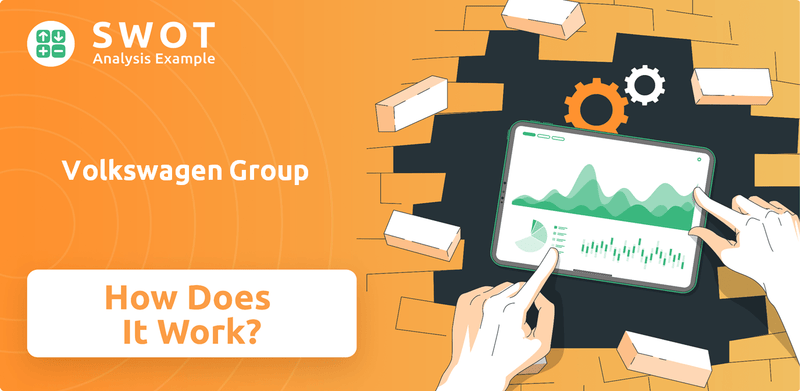
Delving into the Volkswagen Group SWOT Analysis reveals the intricate details of its operations. This analysis provides insights into the company's diverse portfolio of Volkswagen brands, subsidiaries, and its complex VW Group structure. Examining its financial performance, management structure, and global presence illuminates how Volkswagen Group makes decisions and navigates the evolving automotive landscape, especially concerning its electric vehicle strategy.
What Are the Key Operations Driving Volkswagen Group’s Success?
The Volkswagen Group creates value through its extensive automotive ecosystem. This includes designing, manufacturing, and selling a wide range of vehicles and related services. The company's core products encompass passenger cars, light commercial vehicles, and heavy commercial vehicles, serving a global customer base.
Key brands like Volkswagen, Audi, Porsche, Škoda, SEAT, and CUPRA cater to various market segments, from volume to luxury. Volkswagen Commercial Vehicles, MAN, and Scania address the commercial sector, while Ducati represents its presence in the motorcycle segment. The VW Group structure allows for distinct brand identities while leveraging synergies across its diverse portfolio.
Operational processes are highly integrated, utilizing economies of scale through common platforms and shared technologies. The Scalable Systems Platform (SSP) is being developed as the next-generation all-electric, fully digital mechatronics platform. The company's global production network includes 100 production facilities across 27 countries. The company is also focusing on in-house software development through its subsidiary CARIAD, aiming for a 60% in-vehicle software share for vehicles launched on the SSP architecture. Supply chain management is a critical aspect, with a focus on digitalized supply chains and AI-optimized processes.
The Volkswagen Group operates a multi-brand strategy, each targeting specific market segments. Brands like Volkswagen, Škoda, and SEAT focus on volume segments, while Audi and Porsche cater to premium and luxury markets. This approach allows the group to capture a broad customer base and maximize market share.
The Volkswagen Group's global production network spans across 27 countries with 100 production facilities. This extensive network supports efficient manufacturing and distribution. The company is investing in digitalized supply chains and AI-optimized processes to enhance efficiency and resilience.
The Volkswagen Group is investing heavily in technology and innovation, particularly in electric vehicles and software development. The Scalable Systems Platform (SSP) is a key initiative for the next generation of all-electric vehicles. In-house software development through CARIAD is crucial for enhancing in-vehicle functionality.
The Volkswagen Group enhances its value proposition through financial services, including financing, leasing, and fleet management. This integrated approach strengthens customer relationships and supports sales. These services contribute to customer loyalty and overall financial performance.
The Volkswagen Group's operations are characterized by a focus on efficiency, innovation, and customer satisfaction. This includes leveraging economies of scale, developing cutting-edge technologies, and providing comprehensive services. The group's strategy is designed to maintain its market leadership and adapt to the evolving automotive landscape.
- Global Production Network: 100 production facilities worldwide.
- Electric Vehicle Strategy: Development of the SSP platform for electric vehicles.
- Software Development: In-house software development through CARIAD.
- Brand Portfolio: Diverse brands catering to various market segments.
Volkswagen Group SWOT Analysis
- Complete SWOT Breakdown
- Fully Customizable
- Editable in Excel & Word
- Professional Formatting
- Investor-Ready Format
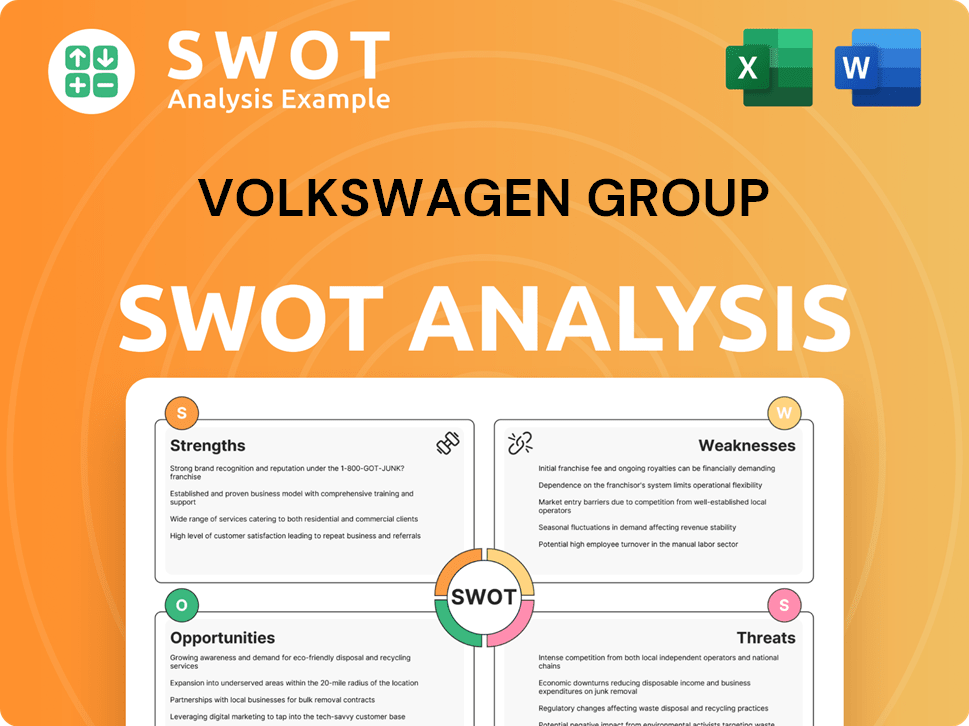
How Does Volkswagen Group Make Money?
The Volkswagen Group generates revenue primarily through its Automotive Division and Financial Services Division. In 2024, the company reported total sales revenue of EUR 324.7 billion, slightly up from EUR 322.3 billion in 2023. The operating result for 2024 was EUR 19.1 billion, a decrease from EUR 22.5 billion in 2023, with an operating margin of 5.9%.
For the first quarter of 2025, sales revenue rose to EUR 77.6 billion, up 2.8% from Q1 2024 (EUR 75.5 billion), though the operating result decreased to EUR 2.9 billion from EUR 4.6 billion in Q1 2024. The Automotive Division, which includes vehicle sales, is the main revenue driver for the Volkswagen company.
The Financial Services Division is another significant revenue stream, encompassing dealer and customer financing, leasing, banking, insurance, and fleet management. The growth in financial services helped offset a slight decrease in automotive business revenue in 2024 due to reduced volumes. The VW Group structure is designed to support these diverse revenue streams effectively.
The Automotive Division is the primary source of revenue for the Volkswagen Group. It is responsible for the sales of vehicles across various Volkswagen brands and Volkswagen subsidiaries. In 2024, Volkswagen Passenger Cars delivered 3,109,007 vehicles (excluding China, including external manufacturing), generating sales revenue of EUR 88.26 billion. For the first quarter of 2025, Volkswagen Passenger Cars delivered 726,267 vehicles, with sales revenue of EUR 21.2 billion. Škoda Auto had its best financial year ever in 2024, and in Q1 2025, delivered 238,600 vehicles, generating EUR 7.259 billion in sales revenue. SEAT S.A. generated sales revenue of EUR 3.895 billion in Q1 2025.
- Vehicle Sales: The core revenue stream from selling vehicles across different brands.
- Parts and Accessories: Sales of spare parts and accessories contribute to revenue.
- After-Sales Services: Revenue from maintenance, repairs, and other after-sales services.
- Licensing and Royalties: Revenue from licensing intellectual property.
The Financial Services Division provides essential financial products and services. This division supports the automotive business by offering financing options, leasing, and insurance to customers and dealers. The strong performance of this division helps stabilize the overall financial results of the Volkswagen company. This is a key part of how the Volkswagen Group is structured to ensure financial stability and growth.
- Dealer and Customer Financing: Providing loans and financing options for vehicle purchases.
- Leasing: Offering vehicles for lease to both individual and corporate customers.
- Banking Activities: Providing banking services.
- Insurance: Offering insurance products related to vehicles.
The Volkswagen Group is actively exploring new monetization strategies to diversify its revenue streams and capitalize on emerging opportunities. The company is focusing on mobility solutions, including a growing portfolio of mobility services. The 'Vehicle Lifetime Concept' is being used to utilize opportunities in the second and third lifecycle of vehicles, including optimized remarketing. The company's push into electric vehicles and software-defined vehicles also opens avenues for future revenue streams. You can learn more about the company's marketing approach in the Marketing Strategy of Volkswagen Group.
- Mobility Services: Expanding into mobility services like ride-sharing and car-sharing.
- Software Services: Offering software updates and subscriptions for connected car features.
- Data Monetization: Utilizing vehicle data for various services and partnerships.
- Used Car Market: Optimizing the used car market through remarketing and other strategies.
Volkswagen Group PESTLE Analysis
- Covers All 6 PESTLE Categories
- No Research Needed – Save Hours of Work
- Built by Experts, Trusted by Consultants
- Instant Download, Ready to Use
- 100% Editable, Fully Customizable
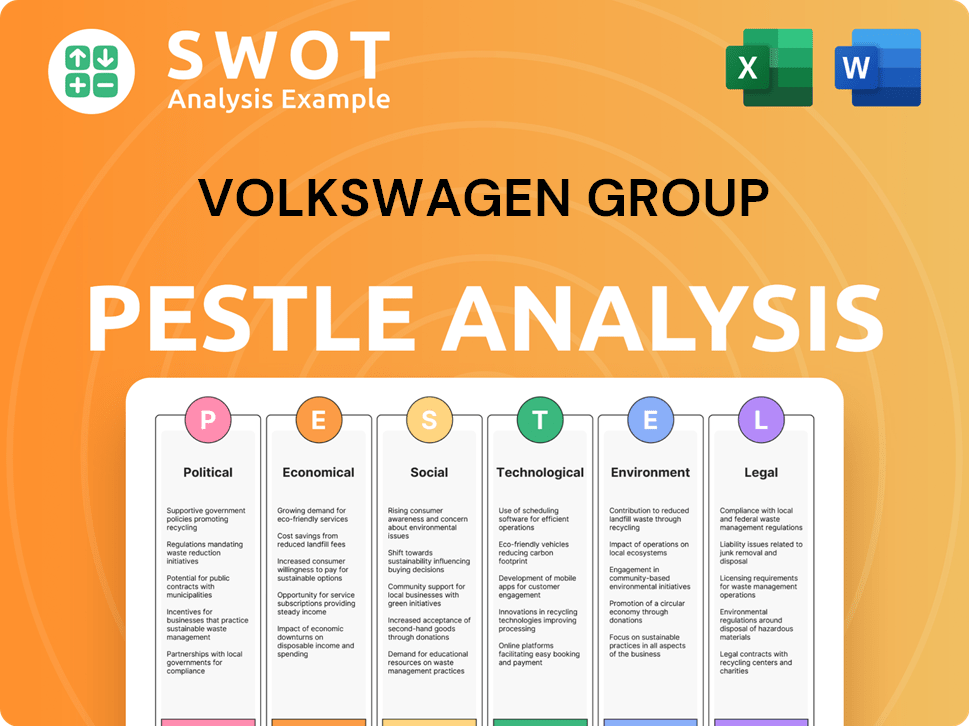
Which Strategic Decisions Have Shaped Volkswagen Group’s Business Model?
The Volkswagen Group has a rich history marked by significant milestones, strategic shifts, and a drive to maintain its competitive edge in the global automotive industry. The company's evolution reflects its adaptability and its ability to respond to changing market demands, technological advancements, and economic conditions. Understanding the key aspects of the VW Group structure, its strategic moves, and the factors that contribute to its competitive advantage is crucial for anyone interested in the automotive sector.
A primary strategic focus for the Volkswagen company is its investment in electric mobility and digitalization. This commitment is demonstrated by substantial financial allocations and ambitious targets for electric vehicle (EV) production and sales. The VW Group's response to market challenges, including fluctuations in demand and intense competition, highlights its proactive approach to maintaining profitability and market share. These strategic initiatives are vital for positioning the company for future success in a rapidly evolving industry.
The VW Group's competitive advantages are multifaceted, stemming from its diverse portfolio of Volkswagen brands, economies of scale, technological leadership, and strategic market approaches. These elements enable the company to cater to a wide range of customers, optimize costs, and maintain a strong presence in key markets. By examining these aspects, it's possible to gain a comprehensive understanding of how the VW Group operates and competes in the global automotive landscape.
The VW Group has achieved several significant milestones, including the expansion of its brand portfolio and its global market presence. The company has strategically invested in new technologies, such as electric vehicles and digital services, to stay ahead of industry trends. These milestones reflect the company's ability to adapt to changing market conditions and consumer preferences.
A major strategic move is the aggressive investment in electrification and digitalization, with nearly EUR 60 billion allocated between 2020 and 2024. The company is developing platforms like MEB and SSP for BEVs. In Q1 2025, global customer deliveries of battery electric vehicles (BEVs) increased by 58.9% year-on-year to 216,800 units, with Europe seeing a 112.6% rise.
The VW Group's competitive advantages include its diverse portfolio of strong global brands, economies of scale, and technological leadership. The company leverages common platforms across models, leading to cost savings. The 'In China, for China' strategy for localized development and production strengthens its position in key markets.
The company has faced challenges, including weaker demand for EVs and supply chain disruptions. In response, Volkswagen implemented performance programs across its volume brands, such as 'Zukunft Volkswagen', aiming for continuous earnings increases. The program also laid the foundation for a socially responsible reduction of over 35,000 jobs across German locations by 2030 and a sustainable cost saving of more than EUR 15 billion per year in the medium term.
The VW Group is focusing on several key initiatives to drive future growth and maintain its competitive edge. These include cost discipline, accelerating its global software strategy, and strengthening its regional presence, especially in the US with initiatives like the relaunch of the Scout SUV firm.
- Investment in electric mobility and digitalization, with significant financial allocations.
- Development of platforms like MEB and SSP for BEVs.
- Implementation of performance programs to improve earnings and reduce costs.
- Focus on cost discipline and strengthening regional presence.
Volkswagen Group Business Model Canvas
- Complete 9-Block Business Model Canvas
- Effortlessly Communicate Your Business Strategy
- Investor-Ready BMC Format
- 100% Editable and Customizable
- Clear and Structured Layout
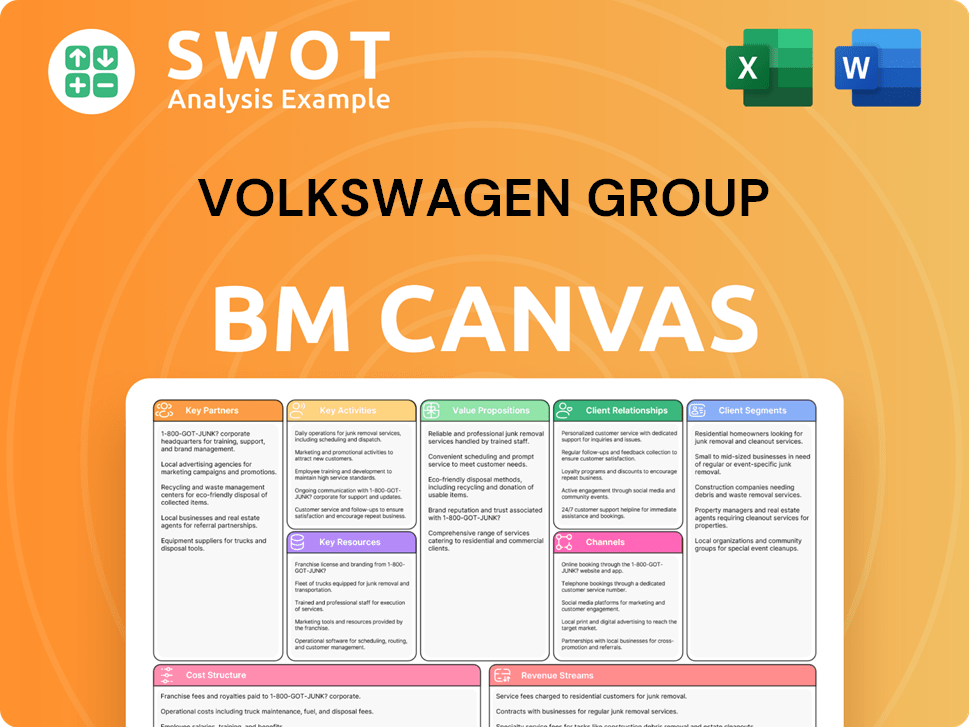
How Is Volkswagen Group Positioning Itself for Continued Success?
The Volkswagen Group maintains a strong position in the global automotive market. It was the world's second-largest automaker by sales in 2024 and has been the market leader in Europe for over two decades. In Germany, the Volkswagen company held a dominant market share of 19.1% in 2024.
Despite its leading position, the VW Group structure faces several risks. These include political uncertainties, increasing trade restrictions, geopolitical tensions, and intense competition. Additional challenges include volatile commodity and energy markets, more stringent emissions regulations, and the shift to electric vehicles. Furthermore, the company carries a significant debt, estimated at EUR 155.6 billion in its 2023 financial report.
The Volkswagen Group is a global leader in the automotive industry. It consistently ranks among the top automakers worldwide, with a substantial market share in Europe. The company's strong brand portfolio and diverse product offerings contribute to its robust market position.
The company faces several risks, including economic and political uncertainties, and intensifying competition. The transition to electric vehicles and stringent emissions regulations also pose significant challenges. Financial risks include high debt levels and volatile commodity prices.
The company is focused on shaping the future of mobility. Strategic initiatives include the continuous introduction of new models, regionally tailored products, and strong partnerships. The company aims for an operating return on sales between 5.5% and 6.5% in 2025.
The company is accelerating its global software strategy and restructuring its business areas. A key focus is on the ramp-up of affordable e-mobility and battery cell production. The company aims to maintain a leading market share in Europe and increase its presence in China.
The Volkswagen Group is actively working towards becoming 'The Global Automotive Tech Driver' by 2035. Key strategies involve expanding e-mobility, developing autonomous vehicle fleets, and establishing battery cell production. The company's financial targets include achieving an operating return on sales between 5.5% and 6.5% in 2025.
- Focus on cash flow and profitability.
- Regional balance, aiming for a 15% market share in China.
- Maintaining a leading share of 21% in Europe.
- Enhancing product and brand quality.
For more detailed insights into the company's growth strategy, consider reading about the Growth Strategy of Volkswagen Group.
Volkswagen Group Porter's Five Forces Analysis
- Covers All 5 Competitive Forces in Detail
- Structured for Consultants, Students, and Founders
- 100% Editable in Microsoft Word & Excel
- Instant Digital Download – Use Immediately
- Compatible with Mac & PC – Fully Unlocked
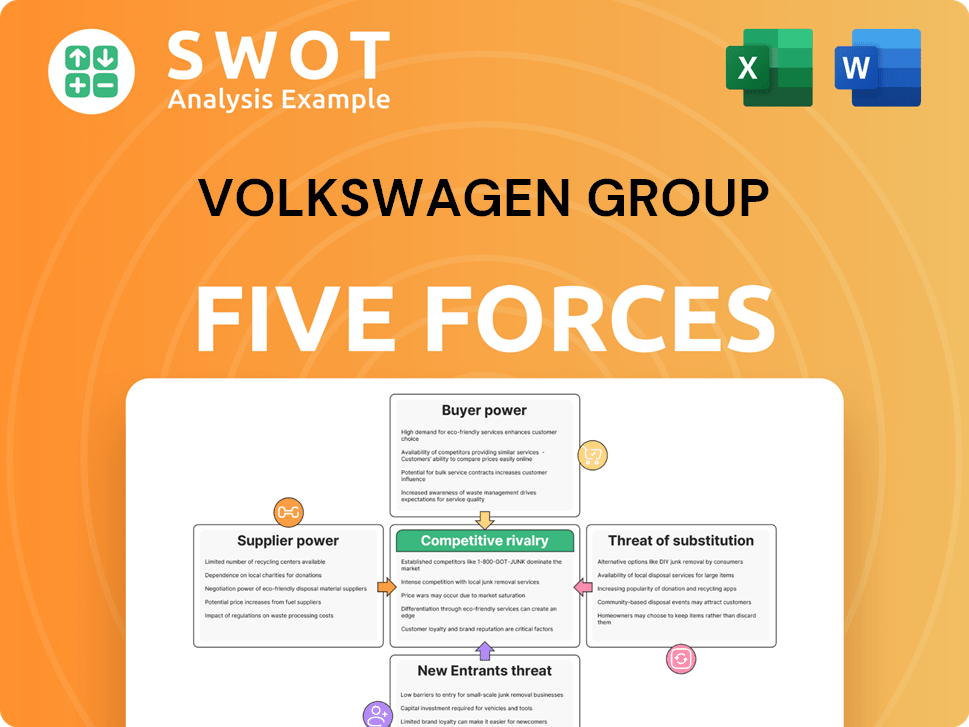
Related Blogs
- What are Mission Vision & Core Values of Volkswagen Group Company?
- What is Competitive Landscape of Volkswagen Group Company?
- What is Growth Strategy and Future Prospects of Volkswagen Group Company?
- What is Sales and Marketing Strategy of Volkswagen Group Company?
- What is Brief History of Volkswagen Group Company?
- Who Owns Volkswagen Group Company?
- What is Customer Demographics and Target Market of Volkswagen Group Company?
Disclaimer
All information, articles, and product details provided on this website are for general informational and educational purposes only. We do not claim any ownership over, nor do we intend to infringe upon, any trademarks, copyrights, logos, brand names, or other intellectual property mentioned or depicted on this site. Such intellectual property remains the property of its respective owners, and any references here are made solely for identification or informational purposes, without implying any affiliation, endorsement, or partnership.
We make no representations or warranties, express or implied, regarding the accuracy, completeness, or suitability of any content or products presented. Nothing on this website should be construed as legal, tax, investment, financial, medical, or other professional advice. In addition, no part of this site—including articles or product references—constitutes a solicitation, recommendation, endorsement, advertisement, or offer to buy or sell any securities, franchises, or other financial instruments, particularly in jurisdictions where such activity would be unlawful.
All content is of a general nature and may not address the specific circumstances of any individual or entity. It is not a substitute for professional advice or services. Any actions you take based on the information provided here are strictly at your own risk. You accept full responsibility for any decisions or outcomes arising from your use of this website and agree to release us from any liability in connection with your use of, or reliance upon, the content or products found herein.